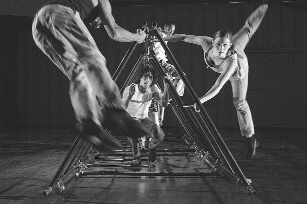Wire Monkey Dance taps humanity at the core
The mass of eager and curious spectators packing themselves around the performance space of Wire Monkey Dance served as the best kind of promotion. This dance company was part of the gathering at Lincoln Center for Out of Doors 2006, an annual free summer festival inviting viewers to experience traditional and contemporary art from various cultures around the world. From a distance, the dancers could already be seen swinging confidently on 19 to 20-foot scaffoldings. Critics rave about the “gravity-defying, acrobatic” dances Wire Monkey has become well known for.
Of course expectations were high, but mid-performance the Wire Monkey had lost quite a few audience members and it was easy to understand why. Hopes of amazing aerial stunts were deflated by the unexpected mildness of choreography atop the scaffolds. Height had little effect on the style or execution of the dance and as Wire Monkey climbed, dismounted, and dangled from the scaffolds, they came off as ordinary gymnasts holding back; the intended goal was lost on many.
The idea behind Wire Monkey Dance existed long before the company formed six years ago. During the ‘70s or ‘80s, scaffoldings set up strictly for construction purposes doubled as monkey bars for children and teenagers to perform tricks on, wanting to impress friends. The fact that Saliq Francis Savage, head choreographer and general artistic director of the troupe, cultivated a low profile practice into a genre of dance is amazingly innovative.
Exaggerated reviews tend to portray Wire Monkey Dance as a circus attraction featuring daredevils; the undermining of anticipation tends to deter an audience’s attention from an indeterminate message yet an unmistakable value. After the opening, the performers assembled their jungle gym to music riddled with the clanging and drilling sounds of a construction site. Like the youth of the past, they played in union with the pieces, creating slides with loose platforms or wheeling each other around in detached frames.
Upon completion, one dancer wearing a necktie set himself apart from the others by physically bossing them around. Music that channeled a sudden balefulness accompanied the tie-adorned terpsichorean as he frightened, bullied, and ordered his fellow dancers. The oppressed gathered in familiarity within the oppressor’s wake.
The cycle of dominance and fear in human and animal relationships is common; but instead of choosing one and focusing on intra-species relations, Savage combines the two. Surrender, support, tyranny, and community are physically and musically rendered, unspoken until bits of confounded words and phrases emit from the speakers.
“Do you have explosives? Do you have an explosive personality? Are we really free?” Emerging in a stifled voice, the first idea those arcane words evoked was 9/11. Meanwhile, one by one, the dancers were entering the confining skeleton of a set aside scaffold at the command of the necktied one to be frisked.
The whole performance could have been about terrorism in the United States; yet the setting also matched the relationship between an unforgiving boss and his employees, a dictator and his people, a chief male lion and his pride, the bully of the playground and his victims. Even in the midst of absolutism, childlikeness still exists, reaching the surface of the performance in small ways—two female dancers play rock, scissors, paper to make a decision.
Wire Monkey Dance captures the pattern of life and relations in general terms and conceptual art. In telling many stories, Savage can also tell one—to live is to make the right connection, to plug into the network of the world, and to maintain the link. If the link fails, then try again. The last scenes of Wire Monkey’s dance regain peace and intimacy when the necktie comes off and the scaffolds are pulled to the ground, banishing the web of sovereignty and serfdom for a preferred interrelationship. The conclusive ending subsists rarely in modern times. Instead, Savage is probably admitting a longing for interaction between peoples, physical and otherwise, to be associated with security and to have priority over power and solitary pursuits. It is how to define ourselves as human.
gaycitynews.com


































